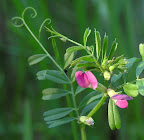
Adult Green Lacewing
In the family Chrysopidae and probably in the genus Chrysoperla. Internet references are unclear on the diet of adult lacewings. It seems to depend upon the genus and species, although many sources do not clearly make this distinction. I'll play it safe and quote BugGuide: Some adults are predators, others take liquids such as honeydew, and some feed on pollen.
All sources agree that lacewing larvae (sometimes called aphid lions) are voracious predators that eat aphids, leafhoppers, spider mites, thrips, moth eggs, and other soft bodied insects. The larvae have a pair of sickle-shaped mandibles which they use to grasp and pierce prey. These mandibles are actually hollow tubes. Lacewing larvae inject enzymes that "pre-digest" their prey. They then suck out the resulting liquified insect innards.
 Lacewing Larvae (Photo from July, 2007)
Lacewing Larvae (Photo from July, 2007)An aphid lion's needle-like mandibles can also pierce and inject enzymes into human skin. For most people the resulting bite will be a minor irritant -- something like a gnat bite. However, as is the case any time foreign protiens are injected into the skin, a few individuals may have an allergic reaction.
Vetch




5 comments:
That Lacewing is so delicate. Beautiful pictures, and in your previous posts, too.
Gorgeous picture of the lacewing on the flower.
These are beautiful, very clear pictures. I don't always have the same success, but I love your shots.
Cheers,
David Webb - Nature Pictures
~/~
These are great shot Marvin.. and great information.
I must be one of the few ones that are allergic. I've caught some biting me and they leave a really nasty blister that can take up to 2weeks to heal.
Post a Comment